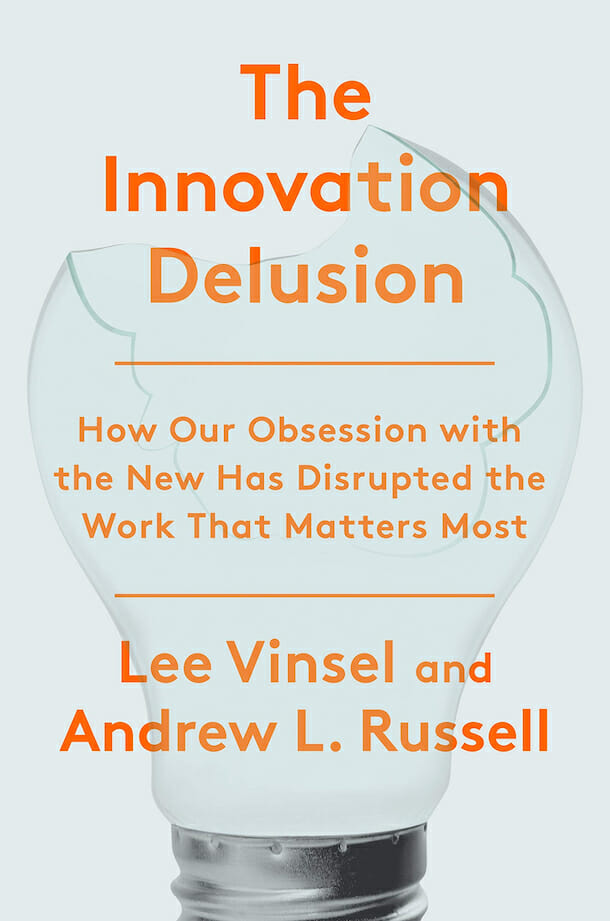
Books
Innovation is a Delusion
If there is one buzzword that encapsulates the contemporary Western mindset, “innovation” might be the best fit. Businesses and business papers constantly write about how to be as “innovative” as Silicon Valley. However, Lee Vinsel and Andrew Russell’s The Innovation Delusion: How Our Obsession with the New Has Disrupted the Work That Matters Most, would caution against such blind pursuit of the I-word.
The authors state their de facto mission statement in the beginning: “We are writing this book because we are sick of hearing about what’s good for Silicon Valley, and what the innovating classes think is good for us.” They explore how innovation culture started to come into vogue with the financialization of the global economy in the 1980s, before going into hyperdrive with the rise of the Internet. Companies of all kinds wanted to emulate the success of Facebook, Amazon, and Google. This desire extended into the wider culture. People began writing self-help books and crafting yoga classes with “innovation” and “disruption” in the title. Consulting groups like IDEO were among the foremost reasons for this trend. Vinsel and Russell opine, “Innovation- speak is fundamentally dishonest. While it is often cast in terms of optimism, talking of opportunity and creativity, and a boundless future, it is in fact the rhetoric of fear.” Mature corporations became afraid of “falling behind” in the innovation race, even though they were founded upon quite different principles than millennial tech companies.
Among the victims of these innovation consultants’ grift was GE. The book devotes much of chapter 5 to documenting its precipitous decline. Over the past dozen years, the manufacturing/engineering giant has lost 5/6 of its market cap. This coincided with the decision of its CEO to try to copy Big Tech’s innovation-obsessive model. Though the roots of the firm’s malaise extend back to the reign of its previous CEO, the famous Jack Welch, who refocused much of the company’s efforts towards financial services (GE Capital).
The second half of the book focuses on the history of maintenance work. The term repairman came into fore around 1850, coinciding with the Industrial Revolution. It became associated with fixing increasingly complex household goods, like appliances and plumbing. With every great innovation came the need for maintenance workers and technicians to keep the products running. The authors make particular note of the Transcontinental Railroad. One of the most innovative infrastructures of all time, it was dependent on a massive team of maintenance workers to keep the trains in peak condition and the railways safe.

Sadly, train maintenance has fallen out of vogue in America. The book cites the epidemic of train delays and derailments that are directly related to poorly maintained trains and railways. This behavior is part of a wider cultural ethos of ignoring maintenance until a problem arises. Both companies and governments fall prey to this mindset and it is costly. Delaying expensive maintenance work leads to even more expensive consequences down the line, such as bridge collapses. This is the dichotomy of deferred maintenance vs preventive maintenance. The U.S. government has firmly chosen the former. For instance, “In 2014, the federal government paid for nearly 40% (or $69 billion) of new infrastructure projects but only 12% (or $27 billion) of operations and maintenance.” Local governments are oftentimes no better. Mayors and governors adopt infrastructure projects that are politically attractive to voters, like highways and asphalt roads, but which they can’t possibly afford to maintain down the road. Further bolstering its point, the book quotes SCE’s 2017 Infrastructure Report Card: “More than half (53%) of public schools need to make investments for repairs, renovations, and modernizations to be considered to be in ‘good’ condition.” Thus, infrastructure funding should be focused on sustaining existing infrastructure, rather than just building new infrastructure.
The authors delve into the lives of maintenance workers. Traditionally, they have been at the bottom of the totem pole. The most notable example of this are India’s “Untouchables,” who are ostracized for the gritty jobs that they perform, like maintaining sewage systems. In the Western context, everyone from janitors to call center reps are routinely humiliated, yelled at, and underpaid. The book estimates that 95% of Americans work as maintainers, as opposed to innovators. There’s a strong correlation between this dichotomy and the booming income inequality, wherein white-collar workers make many times what blue-collar workers do. It’s not all doom and gloom: the book also cites many instances of maintainers who are fighting for their empowerment, as well as diffusing the maintenance worldview in a wider culture that’s become enamored by the “disruption” mindset. Listed are the authors’ three principles of maintenance: maintenance sustains success, maintenance depends on culture and management, and maintenance requires constant care.
The Innovation Delusion is an eye-opening book. It forces us to think about what’s usually taken for granted, such as: what allows the sewage system to work, the lives of maintenance workers, how software is often reliant on teams of volunteers to fix bugs, and the future (as opposed to upfront) costs of infrastructure projects for us, the taxpayers. There are interesting correlations to draw between the Innovation/Disruption culture and the wider ethos of blind consumerism and indifference to the environment’s destruction. Reading this book can cause one to reconsider the details of America’s biggest policy proposals, like Medicare for All (placing a greater emphasis on preventative care and empowering healthcare workers) and the Green New Deal (more of a focus on retrofitting infrastructure to be green, as opposed to just building new infrastructure). Lee Vinsel and Andrew Russell have also created a written testament to maintenance as a whole, which is a topic that is generally neglected.

